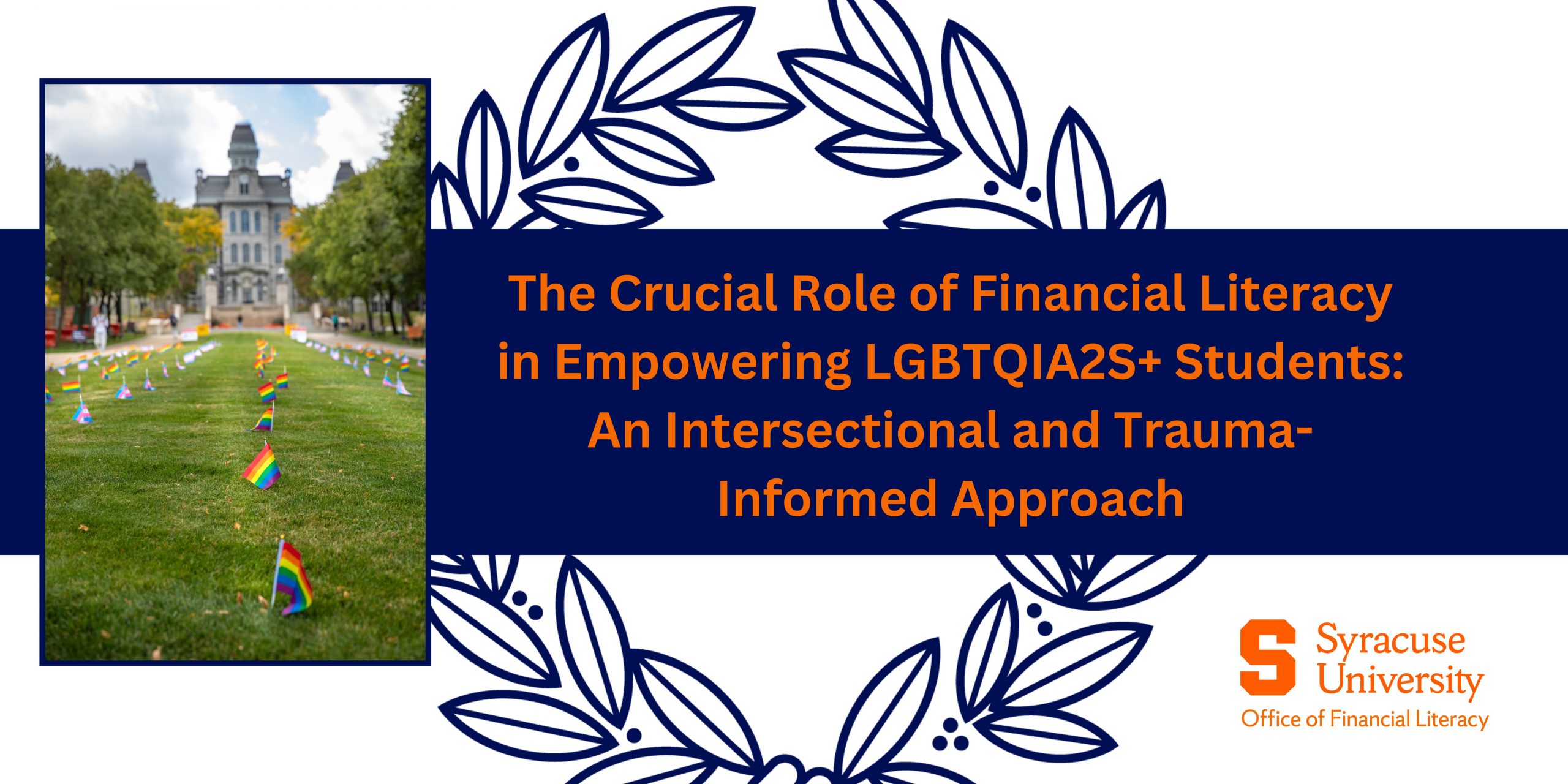By Karina Anderson, June 2024

Financial literacy is a critical component of overall well-being and self-sufficiency, particularly for marginalized communities. For LGBTQIA2S+ students, who often navigate a unique set of financial, social, and emotional challenges, financial literacy can be a transformative tool. This article explores how access to financial literacy affects our LGBTQIA2S+ students through our distinct intersectional and trauma-informed approach within our Financial Literacy programs, underscoring the necessity of tailored financial education programs.
Intersectionality and Financial Vulnerability
LGBTQIA2S+ students frequently face intersectional disadvantages that compound their financial vulnerability. Intersectionality, a concept introduced by Kimberlé Crenshaw, highlights how various social identities such as race, gender, sexual orientation, and socioeconomic status intersect, creating overlapping systems of discrimination and disadvantage (Crenshaw, 1989). For LGBTQIA2S+ students of color, for example, financial challenges are often intensified by racial discrimination, making access to financial literacy even more difficult but imperative.
According to the Human Rights Campaign (HRC), LGBTQIA2S+ individuals, particularly those who are also people of color, are more likely to experience economic instability (HRC, 2020). These students often have fewer family resources to fall back on, either due to familial rejection or because their families are also facing economic hardships and marginalization. Financial literacy programs that consider these intersectional challenges can provide these students with the tools to navigate and overcome systemic barriers, by teaching baseline financial literacy with the added context of social and emotional awareness.
We strive to meet every student where they are within their own individual journeys and empower them to make their own strategic choices.
The Impact of Trauma on Financial Literacy
Many LGBTQIA2S+ students endure trauma, including bullying, discrimination, and rejection, which can significantly affect their financial behaviors and decision-making. Trauma-informed financial education acknowledges the impact of such experiences and seeks to create a supportive learning environment that fosters resilience and empowerment.
Research indicates that trauma can lead to difficulties in managing stress and making sound financial decisions (Miller & Helm, 2020). LGBTQIA2S+ students who have experienced trauma may struggle with budgeting, saving, and long-term financial planning due to the psychological impacts of their experiences. Trauma-informed financial literacy programs, therefore, prioritize creating safe, inclusive spaces where students can learn without fear of judgment or additional stress. Our office offers a wide array of general programming and a commitment to entering trusted spaces to promote accessibility and inclusion within our conversations.
Tailored Financial Education Programs
Effective financial literacy programs for LGBTQIA2S+ students should be designed with their specific needs and challenges in mind. This includes addressing the economic implications of discrimination and providing resources that are sensitive to the realities of LGBTQIA2S+ lives.
For instance, the GLSEN (Gay, Lesbian & Straight Education Network) highlights that LGBTQIA2S+ students often face higher education and housing insecurity, making it essential for financial literacy programs to include modules on scholarships, grants, affordable housing options, and managing student loans (GLSEN, 2021). Additionally, our programs address issues such as planning for medical expenses related to gender-affirming care, which can be a significant financial burden.
Empowerment Through Financial Literacy
Access to financial literacy empowers LGBTQIA2S+ students by providing them with the knowledge and skills needed to achieve financial independence and stability. This empowerment can lead to improved mental health, greater self-confidence, and a higher likelihood of academic and professional success.
A study by the Center for American Progress found that LGBTQIA2S+ individuals who receive financial education are more likely to engage in positive financial behaviors, such as saving for emergencies and retirement (Center for American Progress, 2019). By equipping students with these skills, financial literacy programs can help break the cycle of poverty and marginalization that many LGBTQIA2S+ individuals face.
The Syracuse Universityfinancial literacy program is a vital tool for LGBTQIA2S+ students, providing them with the means to navigate a complex and often hostile financial landscape. When approached from an intersectional and trauma-informed perspective, financial education can address the unique challenges these students face and offer them a path toward financial stability and empowerment.
As educators and policymakers, it is imperative to recognize and address the specific needs of LGBTQIA2S+ students to ensure that financial literacy programs are inclusive, supportive, and effective.
References:
Center for American Progress. (2019). The Economic Impact of Ensuring Paid Family Leave for All Americans. Link.
Crenshaw, K. (1989). Demarginalizing the Intersection of Race and Sex: A Black Feminist Critique of Antidiscrimination Doctrine, Feminist Theory and Antiracist Politics. University of Chicago Legal Forum.
GLSEN. (2021). Educational and Mental Health Disparities for LGBTQIA+ Students. Link.
Human Rights Campaign (HRC). (2020). The Economic Impact of Discrimination. Link.
Miller, P., & Helm, S. (2020). Trauma-Informed Financial Literacy Education. Journal of Financial Therapy.
